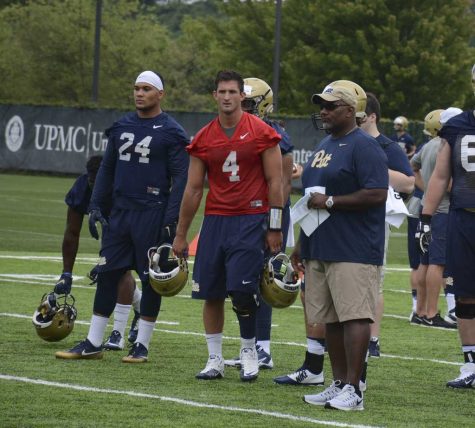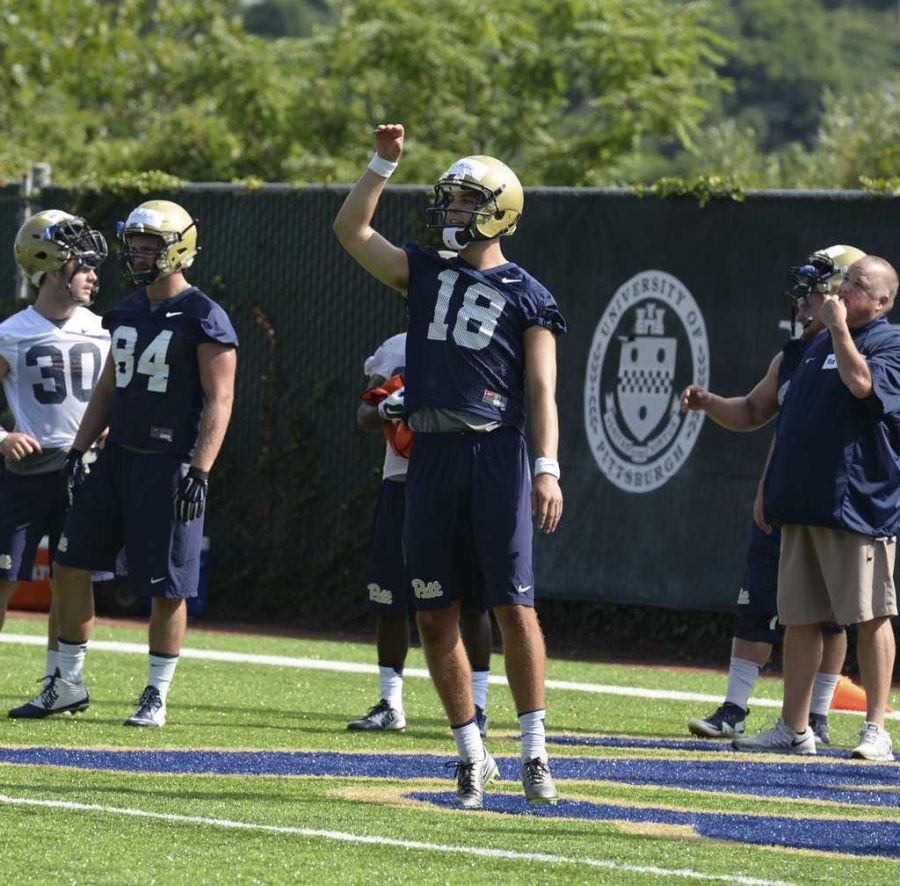Pat Narduzzi is only in his second year as Pitt’s head football coach, but he has no time for low expectations.
“If we don’t think [an ACC Championship is] realistic, we’ve got major issues,” Narduzzi said.
According to Narduzzi, reaching this goal requires a “bigger, faster, stronger football team” — but that doesn’t just mean the bulk of James Conner bearing down on the goal line or the flash of Jordan Whitehead snagging an interception.
It can also mean the swiftness of a gunner racing downfield to down a ball inside the 10, or the power behind the leg of Pitt’s junior punter Ryan Winslow.
For some football players, the fond memories of a parent teaching them how to throw a football in the backyard last forever. For Winslow, the story is a little different.
“[My father] was the one who taught me how to punt,” Winslow said.
Winslow’s father George was the first scholarship punter at Wisconsin and punted in the NFL for two seasons with the Cleveland Browns in 1987 and New Orleans Saints in 1989. As Winslow progressed from a middle to high school to college punter, George has been involved every step of the way.
“[He’s my] support system, he comes to every game,” Winslow said. “It’s awesome to have him by my side.”
Thanks to his father’s guidance, Winslow enters his third season as a key player in Pitt’s pursuit of their first conference title in six years.
“[Our goal is to] have a chance to play in Charlotte,” Winslow said.
That chance can only come from looking at football through a microscope and using an old but true adage about the gridiron.
“[Football is] a game of inches, and there’s an inch everywhere,” Narduzzi said.
Although Narduzzi admits “everybody wants to talk about offense and defense,” to find that inch, he is looking just as much towards special teams to provide it. Andre Powell, Pitt’s special team’s coordinator and running backs coach, knows the alchemy of football — how to turn an inch into six points.
“We’ve got a stat that shows where an offense starts a drive will have a direct correlation on their chances of scoring,” Powell said. “So any time an offense gets the ball inside the 20, they’ve got like a 4 percent chance of scoring a touchdown.”

That means that although a Winslow punt may seem insignificant compared to a Conner run or Whitehead interception, all three add crucial inches for Pitt — or take away crucial inches from the opponent.
Last year, Winslow had 21 of his 63 punts downed inside the 20-yard — or 720 inch — line. Powell thinks he can do better — and even ups the ante.
“Our goal is a little bit higher than that,” Powell said. “If we’re punting the ball from around the 50-yard line, then we want to get them inside the 10.”
For comparison, Utah’s Tom Hackett –– winner of the Ray Guy Award the past two seasons as the best punter in the nation –– had 46 percent of his punts downed inside the 20.
Winslow himself made the watch list for the award this summer, and as someone who wants to have “one of the best punt units in the ACC,” he knows where refinement has to start.
“I think I had seven touchbacks last year, and that’s something I definitely want to improve on,” Winslow said. “The pressure is huge, you only get four, five, six reps a game.”
Winslow knows practice is part of it.
That’s why he spent the summer informally booting balls deep with his special team cohorts. By practicing, they contribute to the symbiotic relationship that binds punter and gunner. They both work together to shed those 720 precious inches away from the opponent’s offense.
“I need to give enough hang time for them to get down the field, and they need to win off the line of scrimmage,” Winslow said.
One of those gunners is junior Avonte Maddox, who, in between starting at cornerback on defense and returning kicks, finds time to contribute flying down the field to pin teams deep.
“I know he’s going to hang it up there for me, and if he hangs it up there for me I can get him a fair catch,” Maddox said. “If he just gives me a few seconds, I get down there.”
And when a deep pin makes the Panther Pitt howl, that only adds to Maddox’s and the rest of the defense’s confidence.
“If they are down there at the 10, I know the percentage to score is really low,” Maddox said.
If Pitt gets the stop? Then that’s a punt from the opponent’s end zone, which means a short field for Pitt’s offense. Those inches Winslow and Maddox gained are transferable.
Special teams isn’t all about the slow grind of a few inches here and there. Looking through last year’s college football season shows how a punt can evolve — or devolve — into the most critical play of the game.
For the Michigan Wolverines, it was devolution.
With 10 seconds left on the clock and a fourth down, Michigan only had to punt the ball away to finish off a 23-21 victory over the undefeated in-state rival Michigan State Spartans. But Michigan punter Blake O’Neill mishandled the snap, and the resultant fumble was returned by the Spartans for a game-winning touchdown as time expired.
Final: Michigan State 27, Michigan 23. Defeat snatched from the jaws of victory.
For Powell –– who’s been a special teams coordinator for 10 of his 30 years as a coach –– it affirms why comfort is key between snapper and punter.
“The snapper with the punter … that’s a critical relationship,” Powell said. “When you see guys that have done it for a long time, you see how smooth and how easy it is.”
Pitt just lost it’s veteran long snapper, David Murphy, who graduated at the end of last year. Powell is confident in his replacement, redshirt senior Pat Quirin, but doesn’t rest easy because he has his man.
“Our job is finding a backup,” Powell said. “[Quirin] could get hurt in the first game.”
Even with a perfect snap, a punt play can still evolve into something far more dramatic than the typical boot.
With four-and-a-half minutes left in the fourth quarter of last year’s game against Syracuse and the score tied, 20-20, then-No. 25 Pitt faced fourth-and-7 at midfield. A good punt from this distance could have trapped the Orange deep in their own territory, giving them a slim chance of driving down for a game-winning score.
But Narduzzi didn’t bother giving the ball back.
Winslow lined up with the special teams unit in punting formation and took the snap, but didn’t kick. Instead, he rolled right and lobbed a pass to linebacker Matt Galambos, who caught the ball for 12 yards — 432 inches — and a first down.
Pitt would grind the clock down, allowing senior kicker Chris Blewitt to nail a game-winning 25-yard field goal as time expired. The 23-20 win brought a 6-1 record, and with it, late-October bowl eligibility to Pitt.
Trick plays like that don’t fit into the the typical job description for a punter –– “Pinning the opponent inside the 10, 20-yard line or forcing fair catches,” as Winslow described.
The fake punt may have helped decide a game, but for Winslow, his focus is still on doing his job.
“That’s just a little addition,” Winslow said with a smile.


